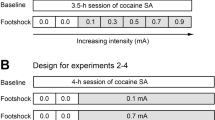Abstract.
Rationale: Repeated access to cocaine may engender behavioral sensitization, which emerges as an enhanced response to the effects of cocaine. Repeated exposure to prolonged self-administration sessions has been shown to produce an escalation in cocaine intake. Objective: The objective of the present study was to identify the consequence of repeated exposure to prolonged access to self-administered cocaine. Methods: Pairs of rats that were matched for training, housing, and surgery were treated as a single experimental unit, and these pairs were separated into groups for two separate experiments. In the first experiment, one animal of the pair acquired and maintained a stable rate for IV cocaine self-administration (0.5 mg/infusion), while the second rat was yoked such that it passively received saline infusions in the same pattern. After acquisition, the active self-administration rats were given free access to cocaine for 16 h (binge), while the yoked animal continued to receive infusions of saline. Twenty-four hours after the binge, both animals were exposed to tactile startle stimuli, and ultrasonic vocalizations (USVs) and startle reflexes were measured. The animals were exposed to three cocaine binges and 24 h post-binge startle tests with an interval of 10 days between binges, and then a fourth binge, with an interval of 24 h separating binges three and four. In the second experiment, pairs of rats were separated into three groups (A, B, and C). The active cocaine rats acquired self-administration and were allowed access to a 16-h cocaine binge while their yoked controls received saline. Twenty-fours hours after the binge, all animals were tested for emission of USVs and startle reflexes with an identical protocol as that in experiment 1. Immediately after exposure to the startle stimuli, the self-administering animals were again allowed to self-administer cocaine for either 16 (group A), 12 (group B), or 8 h (group C). Results: In experiment 1, the total amount of cocaine self-administered was significantly decreased when the cocaine binges were separated by 10 days, but total cocaine intake during the binge significantly increased when the drug-free interval was 24 h. The pattern of self-administration and the withdrawal response remained unchanged over consecutive binges. In experiment 2, rats that self-administered cocaine for either 16 or 12 h emitted significantly less USVs immediately after renewed access than they emitted 24 h after the first access period. Conclusion: It appeared that consecutive prolonged self-administration was insufficient to produce sensitization, as measured by cocaine intake and renewed access to self-administered cocaine was sufficient to reduce the large number of USVs that characterize withdrawal from a cocaine binge.
Similar content being viewed by others
Author information
Authors and Affiliations
Additional information
Electronic Publication
Rights and permissions
About this article
Cite this article
Mutschler, N., Covington III, H. & Miczek, K. Repeated self-administered cocaine "binges" in rats: effects on cocaine intake and withdrawal. Psychopharmacology 154, 292–300 (2001). https://doi.org/10.1007/s002130000646
Received:
Accepted:
Issue Date:
DOI: https://doi.org/10.1007/s002130000646




